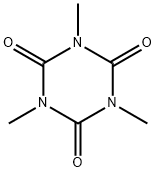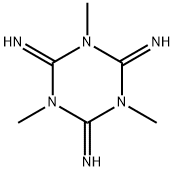
trimethyl isocyanurate synthesis
- Product Name:trimethyl isocyanurate
- CAS Number:827-16-7
- Molecular formula:C6H9N3O3
- Molecular Weight:171.15

67-56-1
757 suppliers
$7.29/5ml-f

598-55-0
342 suppliers
$6.00/25g

827-16-7
20 suppliers
inquiry

115-10-6
96 suppliers
$75.00/25 g

6642-30-4
44 suppliers
$55.00/5g

616-38-6
678 suppliers
$5.00/5 g
Yield:-
Reaction Conditions:
dibutyldimethoxytin in Triethylene glycol dimethyl ether at 173.879; under 5455.88 Torr; for 926 h;
Steps:
2 EXAMPLE 2
A one liter stirred autoclave serves as the reaction zone and reboiler for the reaction/distillation column reactor, which is connected to a 1 inch diameter×3.5 feet long distillation column. The distillation column has three zone heaters, which are independently controlled. The overhead vapor stream from the distillation column is diluted with a nitrogen stream (800 cc/min) and then partially cooled to about 200° F. with hot water in a condenser. The vapor stream from the condenser cooled to ambient temperature to prevent the plugging problem of a cold spot and overhead backpressure regulator. The liquid stream from the condenser flows to a small overhead liquid reflux drum. The temperature of the liquid reflux drum is maintained at ambient temperature. The flow of the liquid product from the overhead reflux drum is monitored with a LFM (liquid flow meter). The liquid stream from the overhead reflux drum and the cooled vapor stream are combined as product stream from the reaction/distillation reactor. Samples are taken for analyses to determine the composition of the overhead vapor stream coming out of the column. Also occasionally samples are taken from the reboiler to monitor the composition of the liquid reaction medium. Whenever the samples are taken from the reboiler, the make-up solutions are pumped in to compensate for the loss of triglyme and catalyst. During the operation of the reactor, the liquid level inside the reboiler is maintained at a constant level. A vertical sight glass is attached to the reboiler for the visual observation of the liquid level inside the reboiler during the operation. Also the reboiler is equipped with a liquid level digital monitor for the automatic control of the reactor during the night and weekends for unattended operation. To carry out the operation of the primary reactor to produce DMC, a MC feed solution (methyl carbamate in methanol) and a methanol feed are pumped in and combined into a single stream. The combined feed stream is passed through a prereactor (a vertically mounted tubular reactor up-flow) at 300° F. and 230 psig to remove water in the feed streams and then introduced to the primary reactor. The temperature of the liquid reaction medium is controlled by adjusting the overhead pressure of the distillation column and the concentration of high boiling solvent in the reboiler of the distillation column. The products DMC, ammonia and other light by-products such as dimethyl ether and CO2 are boiled off from the liquid medium and carried away along with methanol vapor. The operation of the distillation column is carried out in the unconventional mode to perform partial condensation of the vapor coming out of the liquid medium in the reboiler without liquid reflux from the overhead reflux drum by controlling the vapor temperature, which is done by controlling the zone temperatures of the column with three column zone heaters, while the vapor is coming up the distillation column. It was discovered that the unconventional column operation keeps the triglyme solvent in the reactor and continuously removes the by-product N-MMC along with MC from the liquid reaction medium as a part of the overhead stream, which allows the operation of the reactor for an extended period of time. It is found that no liquid reflux from the overhead reflux drum is highly preferred in minimizing the formation of the by-product N-MMC and heterocyclic compounds. It was possible to operate the reaction/distillation column reactor more than 1000 hours without interruption until a high pressure nitrogen valve to the reboiler was accidentally opened. Operating the distillation column in the conventional way causes shutdown or removal of materials from the reboiler, because of the overflow of the reboiler due to the accumulation of the reaction by-products such as N-MMC, cyanuric acid and TTT (1,3,5-trimethyl triazine-2,4,6-trione), etc. Other critical factors to minimize the side-reactions while maintaining an acceptable DMC production rate are balancing the concentrations of solvent and catalyst, the temperature of liquid medium and the overhead column pressure. The range of optimum operation for the reboiler temperature and the overhead column pressure is from about 330 to about 355° F. for the reboiler temperature and from about 80 to about 110 psig respectively. Detailed Description of the Experiment The reboiler of the distillation column was loaded with the following materials; 285 grams of triglyme, 100 grams of methanol and 100 grams of dibutyltin dimethoxide. A steady state operation of the reaction/distillation column reactor was obtained, while pumping in the 13.3 wt. % MC solution in methanol (280 ppm H2O) at a fixed rate of 3.01 ml/min and about 1.92 ml/min of methanol (80 ppm H2O) at 345° F. for the liquid reaction medium in the reboiler, 260° F. for the vapor temperature in the top section of the distillation column, and 90.8 psig for the overhead column pressure. The flow rate of methanol was adjusted to maintain a constant temperature of 345° F. for the liquid reaction medium. The stirring rate of the reboiler was 300 rpm. Under this operational condition, the overhead product stream was composed of ammonia, dimethyl ether, carbon dioxide, DMC, MC, NMMC, water, unknowns and a trace amount (1000 ppb) of catalyst. At 926 hours on stream time, the overheads and the bottoms samples were taken. The analyses of these samples are listed in Table 1. The mole ratio of MC/CH3OH and DMC wt. % based on MC and CH3OH in the liquid medium in the reactor are 1.01 and 4.49 wt. % respectively, which interestingly compare with 2-10 and 1-3 wt. % claimed in U.S. Pat. No. 5,561,094 (1996, EXXON Chem). The result of the experiment corresponds to better than 95 mole % of MC to DMC. This experimental data is used to carry out computer simulation for the process design.
References:
CATALYTIC DISTILLATION TECHNOLOGIES US2005/203307, 2005, A1 Location in patent:Page/Page column 8; 9

67-56-1
757 suppliers
$7.29/5ml-f

598-55-0
342 suppliers
$6.00/25g

827-16-7
20 suppliers
inquiry

75-13-8
89 suppliers
inquiry

115-10-6
96 suppliers
$75.00/25 g

6642-30-4
44 suppliers
$55.00/5g

616-38-6
678 suppliers
$5.00/5 g

624-83-9
1 suppliers
inquiry

827-16-7
20 suppliers
inquiry

6642-30-4
44 suppliers
$55.00/5g

827-16-7
20 suppliers
inquiry

34653-93-5
0 suppliers
inquiry

827-16-7
20 suppliers
inquiry